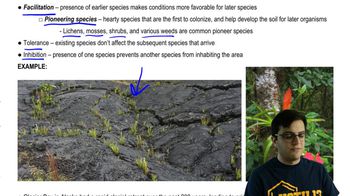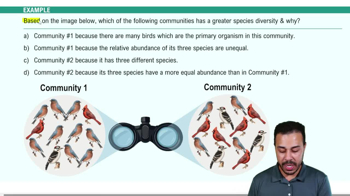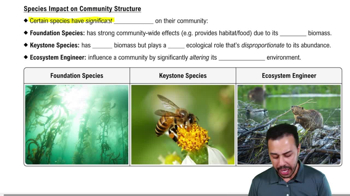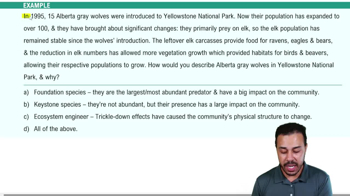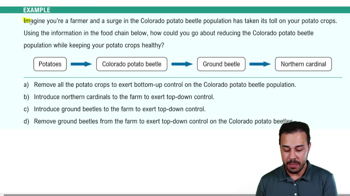Table of contents
- 1. Introduction to Biology2h 42m
- 2. Chemistry3h 40m
- 3. Water1h 26m
- 4. Biomolecules2h 23m
- 5. Cell Components2h 26m
- 6. The Membrane2h 31m
- 7. Energy and Metabolism2h 0m
- 8. Respiration2h 40m
- 9. Photosynthesis2h 49m
- 10. Cell Signaling59m
- 11. Cell Division2h 47m
- 12. Meiosis2h 0m
- 13. Mendelian Genetics4h 44m
- Introduction to Mendel's Experiments7m
- Genotype vs. Phenotype17m
- Punnett Squares13m
- Mendel's Experiments26m
- Mendel's Laws18m
- Monohybrid Crosses19m
- Test Crosses14m
- Dihybrid Crosses20m
- Punnett Square Probability26m
- Incomplete Dominance vs. Codominance20m
- Epistasis7m
- Non-Mendelian Genetics12m
- Pedigrees6m
- Autosomal Inheritance21m
- Sex-Linked Inheritance43m
- X-Inactivation9m
- 14. DNA Synthesis2h 27m
- 15. Gene Expression3h 20m
- 16. Regulation of Expression3h 31m
- Introduction to Regulation of Gene Expression13m
- Prokaryotic Gene Regulation via Operons27m
- The Lac Operon21m
- Glucose's Impact on Lac Operon25m
- The Trp Operon20m
- Review of the Lac Operon & Trp Operon11m
- Introduction to Eukaryotic Gene Regulation9m
- Eukaryotic Chromatin Modifications16m
- Eukaryotic Transcriptional Control22m
- Eukaryotic Post-Transcriptional Regulation28m
- Eukaryotic Post-Translational Regulation13m
- 17. Viruses37m
- 18. Biotechnology2h 58m
- 19. Genomics17m
- 20. Development1h 5m
- 21. Evolution3h 1m
- 22. Evolution of Populations3h 52m
- 23. Speciation1h 37m
- 24. History of Life on Earth2h 6m
- 25. Phylogeny2h 31m
- 26. Prokaryotes4h 59m
- 27. Protists1h 12m
- 28. Plants1h 22m
- 29. Fungi36m
- 30. Overview of Animals34m
- 31. Invertebrates1h 2m
- 32. Vertebrates50m
- 33. Plant Anatomy1h 3m
- 34. Vascular Plant Transport1h 2m
- 35. Soil37m
- 36. Plant Reproduction47m
- 37. Plant Sensation and Response1h 9m
- 38. Animal Form and Function1h 19m
- 39. Digestive System1h 10m
- 40. Circulatory System1h 57m
- 41. Immune System1h 12m
- 42. Osmoregulation and Excretion50m
- 43. Endocrine System1h 4m
- 44. Animal Reproduction1h 2m
- 45. Nervous System1h 55m
- 46. Sensory Systems46m
- 47. Muscle Systems23m
- 48. Ecology3h 11m
- Introduction to Ecology20m
- Biogeography14m
- Earth's Climate Patterns50m
- Introduction to Terrestrial Biomes10m
- Terrestrial Biomes: Near Equator13m
- Terrestrial Biomes: Temperate Regions10m
- Terrestrial Biomes: Northern Regions15m
- Introduction to Aquatic Biomes27m
- Freshwater Aquatic Biomes14m
- Marine Aquatic Biomes13m
- 49. Animal Behavior28m
- 50. Population Ecology3h 41m
- Introduction to Population Ecology28m
- Population Sampling Methods23m
- Life History12m
- Population Demography17m
- Factors Limiting Population Growth14m
- Introduction to Population Growth Models22m
- Linear Population Growth6m
- Exponential Population Growth29m
- Logistic Population Growth32m
- r/K Selection10m
- The Human Population22m
- 51. Community Ecology2h 46m
- Introduction to Community Ecology2m
- Introduction to Community Interactions9m
- Community Interactions: Competition (-/-)38m
- Community Interactions: Exploitation (+/-)23m
- Community Interactions: Mutualism (+/+) & Commensalism (+/0)9m
- Community Structure35m
- Community Dynamics26m
- Geographic Impact on Communities21m
- 52. Ecosystems2h 36m
- 53. Conservation Biology24m
51. Community Ecology
Community Structure
Problem 14d`
Textbook Question
A team of 102 scientists spent a year surveying a small area of the San Lorenzo rain forest in Panama to count the number of species of arthropods living there. After collecting 129,494 specimens—using nets, traps, shovels, tree-climbing harnesses, helium balloons, and other creative gear—it took the team eight years to sort and identify the arthropods. A team of 102 scientists spent a year surveying a small area of the San Lorenzo rain forest in Panama to count the number of species of arthropods living there. After collecting 129,494 specimens—using nets, traps, shovels, tree-climbing harnesses, helium balloons, and other creative gear—it took the team eight years to sort and identify the arthropods. Use the data in the graph to analyze the following statements.
Select True or False for each statement, then correct any false statements to make them true.
T/F All taxa shown in the graph are insects.
T/F All taxa shown in the graph have segmented bodies and limbs.
T/F All taxa shown in the graph are terrestrial.
T/F If the researchers had sampled for mollusks, they probably would have found almost as many species as they did for arthropods.
 Verified step by step guidance
Verified step by step guidance1
Step 1: Analyze the first statement: 'All taxa shown in the graph are insects.' Recall that arthropods include a variety of taxa such as insects, arachnids, crustaceans, and myriapods. Review the graph to determine if all taxa listed are insects or if other arthropod groups are represented.
Step 2: Analyze the second statement: 'All taxa shown in the graph have segmented bodies and limbs.' Understand that arthropods are characterized by having segmented bodies and jointed limbs. Confirm this by reviewing the taxa in the graph and ensuring they all belong to the arthropod phylum.
Step 3: Analyze the third statement: 'All taxa shown in the graph are terrestrial.' Note that while many arthropods are terrestrial, some groups, such as crustaceans, may include aquatic species. Check the graph to see if any aquatic taxa are represented.
Step 4: Analyze the fourth statement: 'If the researchers had sampled for mollusks, they probably would have found almost as many species as they did for arthropods.' Compare the diversity of arthropods to mollusks. Recall that arthropods are the most diverse group of animals, significantly outnumbering mollusks in terms of species richness. Use this biological principle to evaluate the statement.
Step 5: For any statement determined to be false, rewrite it to make it true. For example, if the first statement is false because not all taxa are insects, correct it to reflect the diversity of arthropod taxa shown in the graph.
 Verified video answer for a similar problem:
Verified video answer for a similar problem:This video solution was recommended by our tutors as helpful for the problem above
Video duration:
2mPlay a video:
Was this helpful?
Key Concepts
Here are the essential concepts you must grasp in order to answer the question correctly.
Arthropod Diversity
Arthropods are a diverse group of invertebrates that include insects, arachnids, crustaceans, and myriapods. They are characterized by their segmented bodies, exoskeletons made of chitin, and jointed appendages. Understanding the diversity within arthropods is crucial for analyzing ecological data, as different groups may exhibit varying ecological roles and adaptations.
Recommended video:
Guided course

Arthropods and Chelicerata
Taxonomy and Classification
Taxonomy is the science of classifying organisms into hierarchical categories based on shared characteristics. In the context of the question, understanding the classification of arthropods and other taxa is essential for determining whether all taxa in the graph are insects or if they belong to different groups, which can affect the accuracy of the statements provided.
Recommended video:
Guided course

Introduction to Taxonomy
Habitat and Ecology
Habitat refers to the natural environment in which a species lives, while ecology studies the interactions between organisms and their environment. The question involves assessing whether all taxa are terrestrial, which requires knowledge of the habitats of different arthropod groups and their ecological niches. This understanding is vital for evaluating the statements about species distribution and habitat preferences.
Recommended video:
Guided course

Environment vs. Habitat vs. Niche
Related Videos
Related Practice








